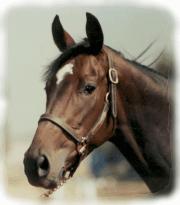A Horse, of Course with Don Blazer |
If you enjoy learning about horses, then you'll love our online courses. Each month you'll find a new column on our web site. We hope you'll enjoy it, and maybe e-mail us with questions or suggestions for other columns. A Horse, Of Course is a monthly column syndicated by Success Is Easy. If you like the column, call your local newspaper, or local horse publication and ask them to subscribe by contacting Success Is Easy. |
The Color of Horses Don Blazer copyright©2011 There have always been questions and opinions about the color of horses, but it’s usually just a matter of splitting hairs. Sometimes it’s a matter of splitting hairs and saying what isn’t the same, is the same, based on what a particular breed registry has ruled. Sometimes it’s a matter of knowing it’s there, but not knowing what to do with it. Sometimes, as in my case, it’s a matter of being stubborn and old school. According to Dr. Ben K. Green, (a recognized authority) the color of a horse is determined by pigment patters, not by pigment color. Dr. Green arrived at that conclusion after splitting a lot of hairs….he did his hair splitting for more than 30 years. Dr. Green found that each hair shaft had the same amount and color of pigment, but each color had its own special pigment pattern. Once he knew the patter, he could tell the color of a horse with one hair. Dr. Green says a horse hair is hollow and that the walls of the hair are clear. There is only one pigment color within the hair, and it is amber. “It is the pigment pattern and density which determines refraction of light, hence the shade of color to the human eye,” says Dr. Green. Dr. Green lists the following colors: dark bay (bays are brown with black mane and tail and black legs) mahogany bay, standard bay, blood bay, light bay, standard brown, seal brown, black, gray, dun, liver chestnut (chestnuts are reddish brown with various colored manes and tails—flaxen to red, the same as body color) dark chestnut, standard chestnut, bright chestnut, dusty chestnut, sorrel, buckskin, copper dun, red roan, blue roan, rose gray and grulla (mouse gray with dorsal stripe and black mane and tail and black legs). Dr. Green lists a lot of color variations and subtle differences for bays and chestnuts. Notice that he lists a lot of chestnut colors, and he names “sorrel” as a separate color. This is one of those cases when what isn’t the same is the same for some breeds and not others. A number of breed registries recognize “sorrel”, but not the Jockey Club which registers Thoroughbreds….so there are no sorrel Thoroughbreds. Sometimes the color is there, but no one knows what to do with it. A horse can be “brindled”, but it can’t be a “brindle.” Brindled means having a coat streaked or spotted with a darker color. It’s rare in horses, but it’s there, yet no breed registries will admit it! (Oh, they know it’s there, they won’t admit it into the registry.) Dr. Green says the only “undesirable colors” of a horse intended for use at the dilute colors—palomino and claybank. (Claybank would include cremellos and true albinos). His comment tends to make palomino, claybank and white horse owners hoof stomping mad. I don’t think they’ve ever forgiven him. My stubbornness and old school thinking tends to upset the owners of some color breed horses, but I don’t really care if they forgive me! I say you ought to be able to determine the color of a color breed horse from 50 feet away. If you can’t tell a paint or pinto horse from 50 feet away, then he ain’t no paint! There is no such thing as a “solid color paint”! If from 50 feet away you can’t tell a palomino is a palomino, he isn’t. If you don’t know instantly that a buckskin is buckskin, then he shouldn’t be registered as a buckskin. If you don’t see spots or a blanket on an Appaloosa, he’s just a grade horse! And if you see an American Quarter Horse with white over his knees, all over his face and blotches of white on his sides, he’s a crop out and needs to find a home in the Paint or Pinto horse registry. What I find the silliest thing about the mixing of blood and colors is that it is done basically to increase cash flow…when it does the exact opposite. People think they can sell more horses if they can sell a half blood (Half Arab) or a “solid color paint” rather than the “real thing.” There doesn’t seem to be much understanding that “few” is “more.” By not diluting blood and mixing it all up, you make the true Arab or the colored Appaloosa worth a lot more money. When you can’t tell a color breed horse from 50 feet away, you make all the horses of that breed worth less. You shouldn’t split hairs when it comes to horses and their true colors. |
